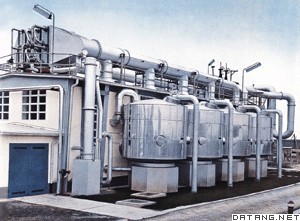1) "Adsorbing"
“吸附”
2) sorption
吸附
1.
The sorption mechanism of chlorobenzenes on CTMAB modified kaolinite;
氯苯类化合物在CTMAB-高岭土上的吸附机理
2.
Modification of Montmorillonite and Advances in Adsorption of Organic Pollutants;
改性蒙脱石对有机污染物的吸附性能研究
3.
Adsorption behavior of copper ion and methylene blue on citric acid-esterified wheat straw;
铜离子和亚甲蓝在柠檬酸酯化麦草上的吸附行为
3) absorption
吸附
1.
Research on absorption of activated carbon in phenyllactic acid fermenting liquor;
苯乳酸发酵液脱色体系中活性炭吸附的研究
2.
Study on treatment of emulsified wastewater by co-coagulation flotation & absorption;
共凝聚气浮破乳吸附法处理乳化废液的研究
3.
Study on Absorption Treatment Waste Leachate With Slag;
炉渣吸附处理垃圾渗沥液的研究
4) absorb
吸附
1.
Study on capability of modify feather absorbing chrome;
改性羽毛对工业废水中Cr_2O_7~(2-)的吸附性能研究
2.
Effect study of powdered zeolite absorbs and resolves ammonium and nitrogen;
粉状沸石吸附及解吸氨氮影响研究
3.
The effects of sepiolite absorbing nano-TiO_2 particles on the formation of hydroxyl free radical;
海泡石吸附纳米TiO_2对·OH基产生的影响
5) adsorb
吸附
1.
Adsorbing and Separating Petunia Red Pigment by Resin;
大孔吸附树脂纯化矮牵牛花红色素
2.
This paper has introduced the investigating status of the technology of saturation adsorbing to reproduce the zeolite,and probed into the principle of it,through summing up and analyzing the technology of saturation adsorbing to reproduce the zeolite,the paper has also put forward the direction of the research for the future.
介绍了饱和吸附沸石再生技术的研究状况,探讨了沸石的再生原理,通过对沸石再生技术的总结和分析,提出了今后的研究方向。
3.
n-Butyl acetate was synthesized from acetic acid and n-butanol using polyvinyl chloride-polythylene polyamine resin which adsorbs metal ions as the catalyst.
采用吸附了金属离子的聚氯乙烯—多乙烯多胺树脂为催化剂,乙酸和正丁醇为原料催化合成了乙酸正丁酯。
6) NO adsorption
NO吸附
1.
PEI chemical modified muli-walled carbon nanotubes and NO adsorption behavior;
多壁碳纳米管的PEI修饰及NO吸附性能研究
参考词条
补充资料:吸附
| 吸附 adsorption 固体表面对气体或液体的吸着现象。固体称为吸附剂 ,被吸附的物质称为吸附质。根据吸附质与吸收剂表面分子间结合力的性质,可分为物理吸附和化学吸附。物理吸附由吸附质与吸附剂分子间引力所引起,结合力较弱,吸附热较小,容易脱附。化学吸附则由吸附质与吸附剂间的化学键所引起,犹如化学反应,吸附常是不可逆的,吸附热通常较大。化工生产中的吸附是一种传质分离过程,利用吸附来将混合物分离,属于物理吸附。当液体或气体混合物与吸附剂长时间充分接触后,系统达到平衡,吸附质的平衡吸附量(单位质量吸附剂在达到吸附平衡时所吸附的吸附质量),首先取决于吸附剂的化学组成和物理结构,同时与系统的温度和压力以及该组分和其他组分的浓度或分压有关。通过改变温度、压力、浓度及利用吸附剂的选择性可将混合物中的组分分离 。工业上主要用于:气体和液体的深度干燥;食品、药品、有机石油产品的脱色、脱臭;有机异构物的分离;空气分离以制取富氧空气;从废水或废气中除去有害的物质等。
|
说明:补充资料仅用于学习参考,请勿用于其它任何用途。
